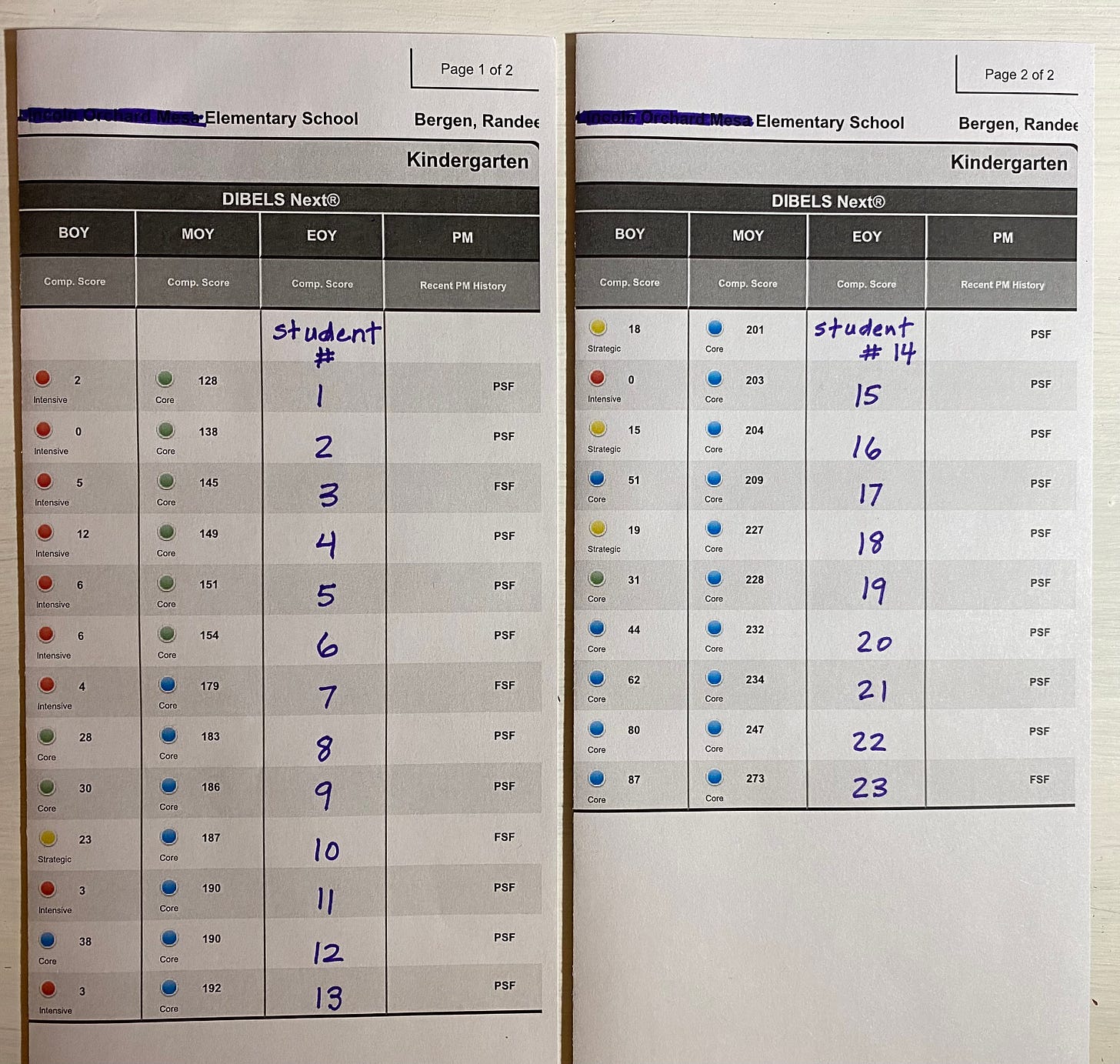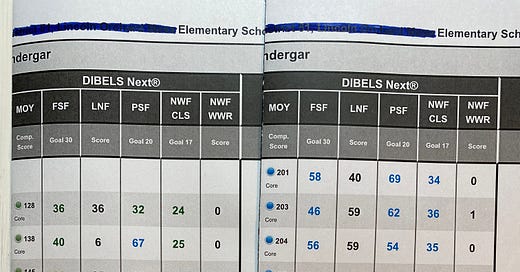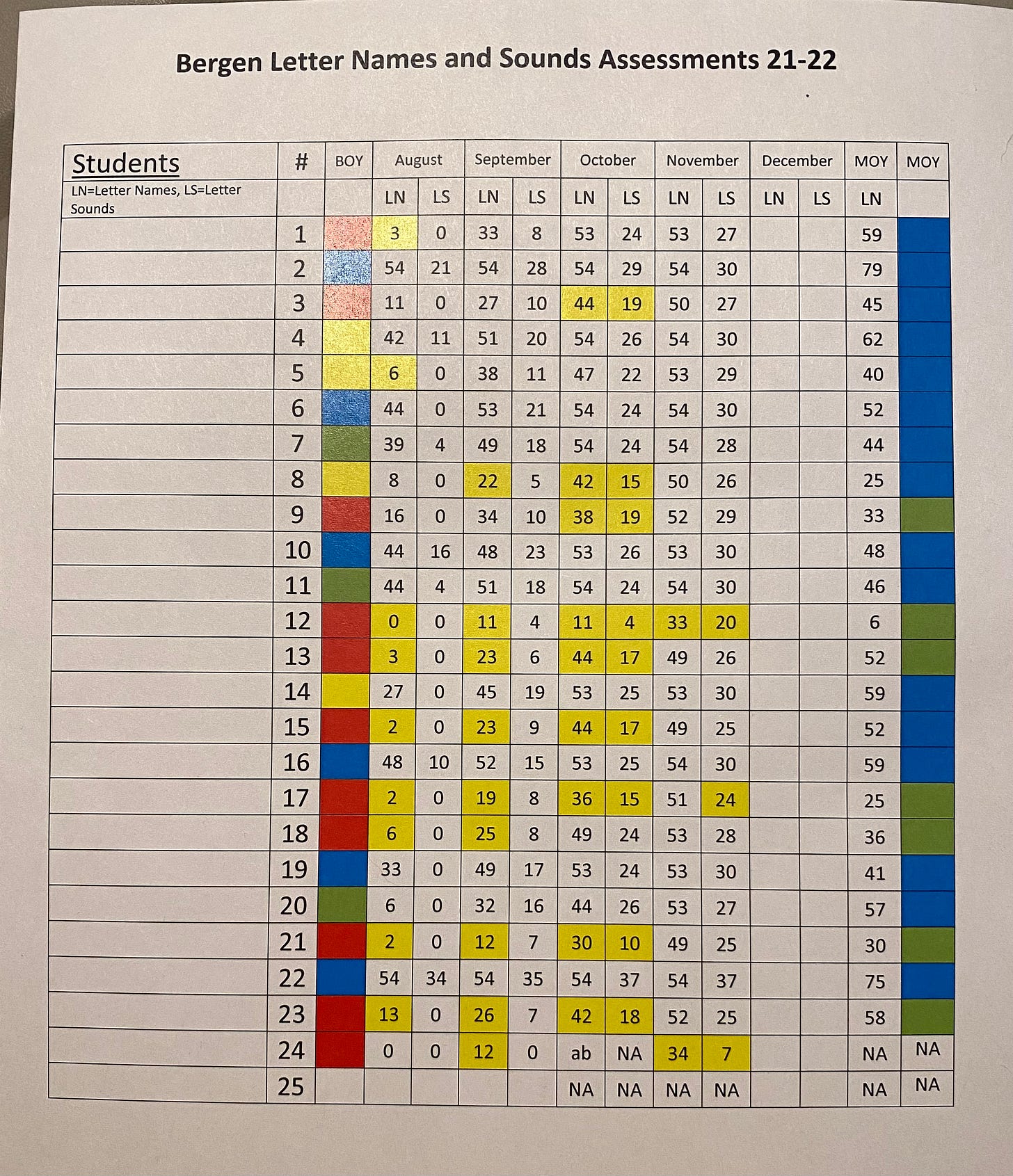Video: 100% At/Above Level on Middle-of-the-Year DIBELS testing
Read and draw, gingerbread man fluency ladder, explanation of DIBELS data
Hello everyone! I hope this post finds you close to your Winter Break and hanging in there. I can’t believe it’s December and yet at the same time I can definitely tell my students have had over 70 days of instruction. Many of them are decoding and blending CVC words and are well on their way to being strong readers by the end of the school year.
This week I completed my middle-of-the-year DIBELS testing and am excited to share that all 23 of the 23 who participate in this test are at or above level! I have six students in the green on-level zone and 17 above-level blue students!

The above picture shows the four different subtests in DIBELS. I will write about this here and I also discuss it in the video (video link is below). Whether you administer the DIBELS test with your students or not, you will probably find this interesting and informative.
First Sound Fluency (FSF)
The first subtest given to kindergartners is first sound fluency. Students are presented with a series of words and they try to tell the first sound heard in the word. The goal is to get 30 of these correct in one minute. My students’ scores ranged from 26-60. While I am pleased with the results, I am in no way surprised. We practice this daily during whole group phonemic awareness time and I assess students individually (both through DIBELS progress monitoring and when we work on Kilpatrick’s phonological training awareness levels) and would be aware if any of them were unable to do this by this point in the school year.
Letter Name Fluency (LNF)
This is an interesting subtest. It must be administered but the score on this subtest is not factored into the child’s composite score. The composite score is comprised of the other three subtests.
I recently took a training with Amplify and learned why letter name fluency is so important but at the same time why it is not a part of the composite score. According to research, letter name fluency is the best indicator of overall reading success. If students can quickly name letters in kindergarten they are more likely to be reading on grade level in future years. And, yet, at the same time, naming letters has nothing to do with reading, really. You can learn letter sounds and blending and advanced phonics and learn to read without ever knowing a single letter name. (No one would suggest not teaching letter names as it would be extremely difficult to function in a classroom and in life if you didn’t know letter names, but it is possible to learn to read without knowing them). So, though it’s important to know if students can fluently name letters, the ability to do so is not a part of the overall score since it is an unnecessary skill. Fascinating!
My students could name 25-79 letters in one minute, except for one outlier. One student could correctly name just six letters in one minute. Although this student knows many letter sounds and is starting to get the hang of blending and reading CVC words, she has great difficulty remembering letter names and numbers. She—as well as a few others—might be green (on level), but they have weaknesses and I have concerns and they will still need intensive interventions.
We practiced quickly naming letters (a mix of lowercase and capitals) often during August and September during small group instruction and my struggling readers still practice this skill several days each week.
Phoneme Segmentation Fluency (PSF)
Phoneme segmentation fluency is the ability to segment words into their individual phonemes. Students must tell all the sounds they hear in a word. The words range from three phonemes to five phonemes, with most of them three or four phonemes. The goal is to tell 20 phonemes during the minute. My class ranged from 32-78 on this subtest. I teach this explicitly every day during whole group phonics instruction and the students put it to use daily during writing time. I also progress monitor on this frequently for red and yellow students and a few times over the course of the fall with the other students so they are used to the subtest by the time the real assessment rolls around.
Nonsense Word Fluency (NWF)
This is the last of the four subtests and the only one that actually involves phonics and reading rather than phonemic awareness activities. Students see nonsense CVC words and have to say as many of the sounds as they can in one minute. Bonus if they can blend the sounds into words and/or just read the word immediately as a whole word. The goal on this subtest is 17 correct letter sounds at the mid-year point. Scores on this subtest in my class ranged from 18-50, with an outlier of 70.
My students started blending two sounds in August and have been blending three for a couple of months now. Whether nonsense or real words, most of them are quite skilled at this for this point in the school year (as shown on many videos over the past few months).

If you study the picture above, you’ll see that my students made incredible growth over the past few months. I had ten red students at the beginning of the year and four yellow ones. We know, as kindergarten teachers, that a student who is red in August may be red because they didn’t pick up any letter names during preschool (a concern and red flag) or because they just haven’t been exposed to letters yet (perhaps a lasting concern, perhaps not). I conduct letter name interventions with all red students at the beginning of the year, so in addition to whole group instruction and small group instruction they get some daily one-on-one time with me. I can tell within a month or so who my true red students are going to be.
All of my reds are now green or blue, but that does not mean that there aren’t students who are struggling and that I am concerned about. I don’t usually compare my students with national norms; I compare them with all the other students who are getting the same instruction from me. So, I will continue to provide extra support for those six students who are just green and not blue. There is a reason they are not blue like all the others. I know they are going to struggle with reading—at least a little bit and perhaps more—down the road.
Six red students are now green and four reds are now blue. All four yellows are now blue and the three greens are all blue also. The blues all stayed blue. To the best of my knowledge (I asked my principal and he found it online), the expected composite score for kindergartners at the end of the year is 119 and all of my students have already obtained that. But, again, that does not mean that I can kick back and take it easy and that we’re all home free. I still have much work to do. I want all 23 of these students to be super strong readers by May.
I also recently conducted my end-of-the month letter name and letter sound assessment with each student and that data chart is shown below.
I highlighted just three students that I will continue to work with specifically on letter names and sounds. My intervention time will change now from intensive letter work to more strategic instruction; in other words, I will work with many students but what we work on will vary and will be based on what I observe during small group instruction, daily writing time, and other times throughout the day. Skills covered will range from blending to handwriting to reading word lists to spelling heart words.
In the video included with this post, you’ll see students doing their first Read and Draw. I talk about it in the video so I won’t repeat myself here. Then, you’ll see students reading short sentences on a gingerbread man fluency ladder. I’ve been looking forward to writing my own decodable texts that match our weekly themes and this was the first one. The students loved it.
At the end of the video, I talk about the DIBELS subtests and scores and you might prefer that as a way to take in the information over reading about it.





Hi there, I've taught intervention and small group for letter fluency and segmenting and blending but my ELLs haven't mastered them. Also, i agree the read and draw are awesome. Would you kindly send me both folders as well.
DIBELS...I recall that some of their materials are free to access. Does your school pay for your access? The more I see of what you are doing with their resources, the more value I see in them as a powerful formative assessment tool!
Do you have more fluency pages like this gingerbread man one from the video? I love them!
Read & Draw - genius! Just pure genius.